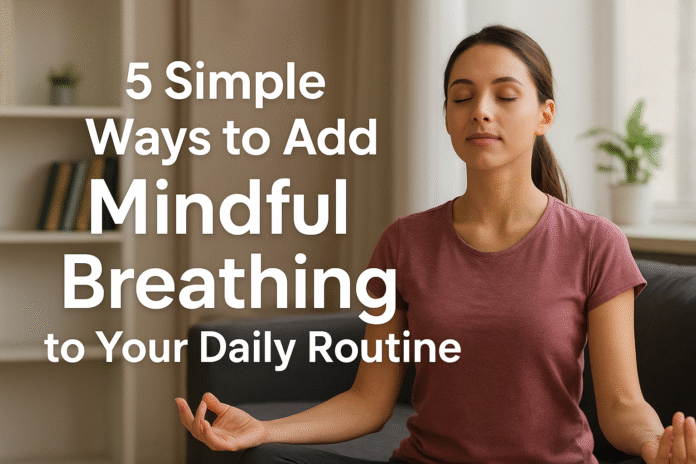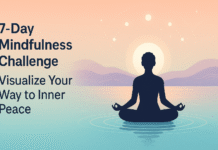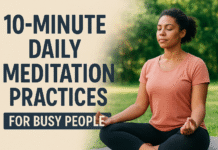Mindful breathing is one of the simplest, most portable tools you can use to steady your mind, reduce stress, and get more focused time out of an otherwise busy day. This article gives you five practical, ready-to-use ways to fold mindful breathing into everyday life — from a 5-minute morning ritual to an on-the-spot calm-down you can do in a meeting or on the subway. You’ll get clear how-to steps, low-cost options, beginner progressions, safety notes, a 4-week starter plan, troubleshooting tips, and short sample mini-plans you can try today.
Medical disclaimer: This article provides general information about breathing practices and stress management. It is not medical advice. If you have chronic respiratory problems, cardiovascular disease, anxiety disorders, or other medical conditions, consult a qualified healthcare professional before starting new breathing exercises.
Key takeaways
- Mindful breathing is quick, free, and portable — it can reduce stress and improve focus when practiced consistently.
- Five practical entry points: morning ritual, desk reset, movement integration, bedtime wind-down, and on-the-go emergency calm.
- No special equipment needed; simple timing, posture, and awareness are often enough.
- Track progress with simple measures (subjective scales, minutes per day, or heart-rate metrics if available).
- Start small and build—a 4-week plan is included to help you form a sustainable habit.
Why mindful breathing matters (short primer)
Breathing is automatic, but the way we breathe affects the nervous system. Slow, deliberate breathing can boost parasympathetic activity (the “rest-and-digest” response), lower stress hormones, and increase heart-rate variability — a marker often linked with better stress regulation. When practiced mindfully, breathing also trains attention: noticing the inhale and exhale pulls you out of rumination and into the present moment, which helps with focus, decision-making, and emotional balance.
1. Morning 5-Minute Breath Ritual: Start your day with clarity
What it is and core benefits
A short, structured breathing routine performed within the first 10–30 minutes of waking to set your mental tone for the day. Benefits include improved alertness, lower morning anxiety, and a clearer ability to plan and prioritize. Doing a short mindful session early builds momentum for the day and makes it more likely you’ll repeat other practices.
Requirements / low-cost alternatives
- Requirements: Quiet-ish spot (bedside, kitchen counter), 5 minutes, a chair or standing space.
- Low-cost alternatives: Do it sitting on the edge of the bed, leaning against the wall, or while making coffee. No apps or devices necessary — a simple timer on your phone will do.
Step-by-step beginner instructions
- Get comfortable. Sit upright at the edge of the bed or in a chair with both feet on the floor. Relax shoulders.
- Place one hand on your belly and one on your chest. This helps you feel diaphragmatic movement.
- Diaphragmatic breathing (2 minutes): Inhale slowly through the nose for a count of 4, allowing your belly to rise; exhale for a count of 6, letting the belly fall.
- Mindful counting (2 minutes): Continue slow breaths and silently count “1” on the inhale, “2” on the exhale, up to 10, then start over—if your mind wanders, gently return to the count.
- Set an intention (30 seconds): On the final exhale, pick a single, practical intention for the morning (e.g., “one task at a time”).
Beginner modifications and progressions
- Simplify: Start with 2 minutes of breathing if 5 feels too long.
- Progress: Extend inhale/exhale counts (e.g., 5 inhale / 7 exhale) or add 1–2 minutes of silent awareness after the counts.
- Add-ons for experienced practitioners: Add a brief body-scan after breathing or connect to a short journaling prompt.
Recommended frequency / duration / metrics
- Frequency: Daily, ideally every morning.
- Duration: 3–10 minutes is typical.
- Metrics: Track days completed per week and subjective morning stress on a 1–10 scale.
Safety, caveats, and common mistakes
- Caveat: If you feel lightheaded, shorten breath counts and breathe normally until you feel steady.
- Common mistakes: Breathing too shallowly (chest-only), forcing breath, or multitasking (checking phone). Keep it simple and present.
Mini-plan (2–3 steps)
- Sit upright, hand on belly.
- Inhale 4 counts, exhale 6 counts for 4 cycles.
- Set one practical intention for the morning.
2. Desk / Work Reset: Box breathing between tasks
What it is and core benefits
Box breathing (also called square breathing) is a rhythmic technique where inhale, hold, exhale, hold are performed for equal counts. It’s widely used as a quick reset to calm the nervous system, increase focus, and interrupt stress-reactivity during the workday. This method is particularly useful before meetings, presentations, or when you feel the tension of looming deadlines.
Requirements / low-cost alternatives
- Requirements: Chair and a quiet break of 1–5 minutes.
- Low-cost alternatives: Perform the same pattern with approximate counts (e.g., 3-3-3-3) without counting aloud.
Step-by-step beginner instructions
- Posture: Sit tall with feet flat and hands relaxed on your lap.
- Set a count: Use 4 seconds as the standard (modify if needed).
- Box pattern: Inhale for 4, hold for 4, exhale for 4, hold for 4 — repeat for 3–6 cycles.
- Return slowly: After the last cycle, take two normal breaths and continue with your task.
Beginner modifications and progressions
- Modify counts: Start with 3 seconds each side if 4 is too long.
- Progression: Increase to 5 seconds per side for longer calm, or combine with a brief visualization (e.g., visualizing each side of the box).
Recommended frequency / duration / metrics
- Frequency: 1–3 times per work hour during stressful periods; before and after high-stakes events.
- Duration: 1–5 minutes per reset.
- Metrics: Count resets per day and rate task focus afterwards (self-rated).
Safety, caveats, and common mistakes
- Safety: Hold periods may be uncomfortable for people with respiratory or cardiac concerns; shorten holds or skip holding phases.
- Mistakes: Rushing the counts or tensing shoulders. Keep the face and jaw relaxed during holds.
Mini-plan (2–3 steps)
- Sit tall. Inhale 4, hold 4, exhale 4, hold 4.
- Repeat 4 cycles.
- Resume work with a brief two-breath check-in.
3. Movement Integration: Mindful breathing while commuting or walking
What it is and core benefits
Integrating mindful breathing into movement (walking, stair climbing, commuting) pairs body rhythm with breath. This technique turns routine motion into a mindfulness practice, giving you stress relief and improved energy without needing extra minutes carved out of the day. Breathing with movement helps anchor attention and can reduce rumination during otherwise automatic tasks.
Requirements / low-cost alternatives
- Requirements: Any walking route or commute where you can safely focus on breath for short windows.
- Low-cost alternatives: Use brief breath-checks while standing in line, waiting for the kettle, or during traffic stops.
Step-by-step beginner instructions
- Start small: Commit to 2–5 minutes of breath-aware walking.
- Coordinate breath to steps: Try a 2:2 pattern (inhale two steps, exhale two steps) or 3:3 for a slower pace.
- Notice sensations: Focus on the rise/fall of your breath and feet contacting the ground.
- Recover: If your mind wanders, note it and return focus to breath and steps.
Beginner modifications and progressions
- Simplify: Begin with a single breath-check—notice three full breaths at a crosswalk.
- Progress: Extend breath-step patterns (e.g., inhale 4 steps, exhale 6 steps) or practice for longer walking commutes.
Recommended frequency / duration / metrics
- Frequency: Use whenever you commute, during breaks, or when walking between meetings.
- Duration: 2–15 minutes per session.
- Metrics: Sessions per week and subjective energy/focus after practice.
Safety, caveats, and common mistakes
- Safety: Maintain situational awareness — don’t zone out in busy traffic or hazardous places.
- Mistakes: Trying complex breath holds while walking or over-focusing on breath and ignoring surroundings.
Mini-plan (2–3 steps)
- At the bus stop, inhale two steps, exhale two steps for 3 minutes.
- On arrival, take three slow, deep diaphragmatic breaths before stepping into the building.
4. Bedtime Wind-Down: 4-7-8 breathing for sleep and relaxation
What it is and core benefits
The 4-7-8 method is a paced breathing pattern designed to quiet the mind and encourage sleep by activating the parasympathetic system and lengthening exhalation. It can help with falling asleep faster and reducing bedtime anxiety when practiced nightly as part of a wind-down routine. Evidence suggests paced breathing can improve sleep onset and reduce pre-sleep arousal for some people.
Requirements / low-cost alternatives
- Requirements: Bedtime environment, 5–12 minutes before sleep.
- Low-cost alternatives: If holding for seven counts is challenging, shorten the hold (e.g., 4-4-6) and gradually increase.
Step-by-step beginner instructions
- Position: Lie on your back or sit propped up in bed.
- Exhale fully: Begin by exhaling completely through the mouth with a soft whoosh.
- Pattern: Inhale quietly through the nose for 4 counts, hold for 7 counts, exhale audibly through the mouth for 8 counts. Repeat 3–4 cycles.
- Relax: Transition to slow normal breathing and let sleep come naturally.
Beginner modifications and progressions
- Simplify: Start with 3 cycles of 3-3-4 counts and build up.
- Progress: Increase cycle count up to 6–8 cycles as tolerance improves.
Recommended frequency / duration / metrics
- Frequency: Nightly as part of a bedtime routine.
- Duration: 3–12 minutes depending on cycles.
- Metrics: Time-to-sleep (minutes), subjective sleep quality, or sleep-tracking apps if you use them.
Safety, caveats, and common mistakes
- Caveat: Those with certain respiratory or cardiac conditions should consult a clinician before prolonged breath holds.
- Mistakes: Forcing breath or straining; use gentler counts if you feel dizzy.
Mini-plan (2–3 steps)
- Lie down and do three cycles of 4-7-8 breathing.
- Follow with two minutes of natural breath awareness and let sleep follow.
5. On-the-Go Emergency Calm: Acute stress management in 60 seconds
What it is and core benefits
A condensed breathing toolkit for acute stress: quick diaphragmatic breaths, lengthened exhalations, or a paced 5-2-6 pattern to interrupt the fight-or-flight surge. This short practice is designed to rapidly down-regulate physiological arousal so you can think clearly and respond rather than react. Studies show even brief breathing interventions can reduce anxiety and physiological markers of stress.
Requirements / low-cost alternatives
- Requirements: Anywhere you have a moment — elevator, bathroom stall, car (parked), or standing on public transport.
- Low-cost alternatives: Use a discreet single-hand on belly technique or count silently.
Step-by-step beginner instructions
- Pause safely. If driving, pull over; if not, find a stable place.
- Diaphragmatic 3-count: Inhale for 3 (nose), exhale for 5 (mouth or nose), repeat 3–6 times.
- Grounding finish: Take two normal breaths and name one physical sensation (feet on ground, chair support).
Beginner modifications and progressions
- Simplify: Use one deep belly breath if longer counts feel awkward.
- Progress: Learn to do 6–8 cycles of paced breath in a calm environment to prepare for on-the-spot use.
Recommended frequency / duration / metrics
- Frequency: As needed during acute stress moments.
- Duration: 30–90 seconds typically effective.
- Metrics: Number of incidents where breath reduced reactivity (self-rated) or time to return to baseline.
Safety, caveats, and common mistakes
- Safety: Don’t hyperventilate or use breath holds during panic attacks without guidance; if you have panic disorder, seek tailored instructions from a clinician.
- Mistakes: Trying to “power through” a panic attack with forced breathing — instead, focus on gentle, slow breaths.
Mini-plan (2–3 steps)
- Stop and inhale for 3, exhale for 5 — repeat 4 times.
- Notice your feet and return to activity.
Quick-start checklist and warm-up
Quick-start checklist
- Comfortable seat or standing place.
- Timer or phone (optional).
- A reminder/trigger (a calendar alert, sticky note, or habitual cue like “after coffee”).
- Hydration (optional).
Warm-up (30–60 seconds)
- Roll shoulders, loosen neck.
- Take three slow, full breaths (inhale through nose, exhale through mouth).
- Place hand lightly on belly to connect to diaphragmatic movement.
Troubleshooting common pitfalls
I get dizzy. Slow down counts, breathe normally until steady, and shorten holds. Avoid rapid, forced breathing.
My mind wanders constantly. That’s normal. Label the distraction (“thinking”) and gently return to breath. Shorter sessions more often beat one long, frustrating sit.
I can’t feel my belly move. Practice lying down with a small book on the abdomen to notice movement, then move to sitting.
Breath practice increases anxiety. If breath holds or intense breathwork cause panic, switch to gentle, normal-paced breathing and consult a clinician if panic persists.
I forget to practice. Use cues tied to existing habits (after brushing teeth, before lunch) and set nonjudgmental goals like “do at least one breath reset each workday.”
How to measure progress or results
Subjective measures (simple and powerful)
- Daily check-in: Rate stress/clarity on a 1–10 scale before and after practice.
- Weekly journal note: One sentence on how breathing affected mood or focus.
Objective-ish measures (optional)
- Minutes practiced per week.
- Heart-rate measures or heart-rate variability via a wearable if you already use one.
- Sleep-tracking metrics for bedtime practices.
What to expect
- Immediate effects: small reductions in tension and clearer thinking after a single session.
- Short-term changes (weeks): improved sleep onset, lower daily anxiety spikes, better focus.
- Long-term changes (months): more automatic calm responses and improved resilience under stress.
4-Week Starter Plan: Build a sustainable mindful breathing habit
Goal: Create a daily habit with small wins that scale to a reliable practice.
Week 1 — Foundation (days 1–7)
- Daily: Morning 3-minute diaphragmatic breathing (see H2 #1).
- Midday: One 60-second box-breath reset before lunch.
- Evening: 3 cycles of 4-7-8 before bed on 3 nights.
Week 2 — Habit formation (days 8–14)
- Morning: Extend to 5 minutes; add mindful counting.
- Work: Two desk resets per workday.
- Movement: Add one 5-minute mindful walk on three days.
Week 3 — Consolidation (days 15–21)
- Morning: 5–8 minutes total (diaphragmatic + count).
- Work: Use box breathing proactively before high-stakes tasks.
- Evening: 4-7-8 nightly (4–6 cycles); track sleep time-to-sleep.
Week 4 — Personalization (days 22–28)
- Choose the two most useful methods for you and make them daily habits.
- Add a weekly review: note perceived stress, sleep, and focus improvements.
- Increase one practice by 1–2 minutes if comfortable.
Simple tracking
- Use a habit app or a 7×4 grid (weeks x days) and mark completed practices.
- Rate nightly sleep and morning stress on a scale of 1–5.
Safety, caveats, and when to seek help
Breathing exercises are generally safe for healthy people, but there are important cautions:
- If you have asthma, COPD, cardiorespiratory disease, severe psychiatric conditions, or recent cardiovascular events, consult your clinician before trying breath holds or dramatic pace changes. Some breathing patterns (long holds, forceful breaths) can be stressful for certain medical conditions.
- If breath practices cause severe dizziness, numbness, or panic, stop and resume normal breathing; seek guidance from a healthcare professional.
- For clinical anxiety, panic disorder, or trauma-related conditions, breathing can be helpful but should ideally be integrated under clinical supervision or within a therapeutic plan.
Troubleshooting: common pitfalls and fixes
Problem: “I don’t have time.”
Fix: Use the on-the-go emergency calm for 30–90 seconds. Micro-sessions add up.
Problem: “I can’t breathe slow.”
Fix: Start with shorter counts (3:4 or 3:5) and build gradually.
Problem: “I fall asleep during breathing.”
Fix: If daytime practice causes sleepiness, shorten the session or shift to times you need alertness. For bedtime, that’s an intended outcome.
Problem: “I feel more anxious after breathing.”
Fix: Reduce the intensity and avoid long holds. Use gentle diaphragmatic breaths and seek professional guidance if anxiety continues.
Frequently Asked Questions (10)
1. How long before I see benefits from mindful breathing?
You may feel immediate calming effects after a single session. More consistent changes in sleep, anxiety, or focus often appear over weeks of regular practice.
2. Can breathing exercises replace therapy or medication for anxiety?
No. Breathing exercises are a helpful self-management tool but are not a substitute for professional treatment when clinically indicated. Consult a healthcare provider for personalized care.
3. Is there an optimal breathing rate for stress reduction?
Many relaxation techniques aim for slow breathing around 4–6 breaths per minute (longer exhalations relative to inhalations). Individual comfort matters; start slower and adjust.
4. Can children use mindful breathing?
Yes — but shorter, playful exercises work best (e.g., “smell the flower, blow the candle”). For clinical issues, work with pediatric providers or therapists.
5. Will breath practice change my blood pressure or heart health?
Some research shows diaphragmatic and paced breathing can modestly lower blood pressure and improve heart-rate variability over time. People with cardiovascular conditions should consult their clinician first. ScienceDirect
6. Can I combine breathing with other practices like yoga or meditation?
Absolutely. Breath is central to many movement and contemplative practices and pairs well with short meditations, stretching, or mindful walking.
7. What if breathing makes me lightheaded?
Slow down or shorten your counts and breathe normally until the feeling passes. Never force extended breath holds.
8. Are some techniques better for sleep vs. alertness?
Yes. Longer exhalations and practices like 4-7-8 are better for sleep and relaxation; short, rhythmic breathing or energizing breathwork (pranayama variants) can be used for alertness. Adjust based on goals.
9. How do I maintain the habit once I finish the 4-week plan?
Choose the two methods you find most helpful and tie them to established daily cues (morning coffee, lunch break, bedtime). Keep tracking simple and forgiving. TIME
10. Can breath practice help with performance anxiety (presentations, sports)?
Yes. Short paced breathing and box breathing are practical tools to reduce arousal before performances and improve focus. Practice in low-stakes situations so the technique becomes automatic.
Conclusion
Mindful breathing is a highly accessible skill that produces immediate relief and cumulative benefits when practiced consistently. Whether you choose a morning ritual, a desk reset, a mindful movement routine, a bedtime wind-down, or a 60-second emergency calm, the key is small, consistent steps. Start with what feels doable, track it, and let the habit expand naturally.
Call to action: Try one of the five methods today — pick one mini-plan and commit for four weeks.
References
- Breathing Practices for Stress and Anxiety Reduction — National Library of Medicine (PMC), Publication date: 2023. https://www.ncbi.nlm.nih.gov/pmc/articles/PMC10741869/ PMC
- Effects of Diaphragmatic Breathing on Health: A Narrative Review — National Library of Medicine (PMC), Publication date: 2020. https://www.ncbi.nlm.nih.gov/pmc/articles/PMC7602530/ PMC
- Inclusion of a Rest Period in Diaphragmatic Breathing Increases Heart Rate Variability — National Library of Medicine (PMC), Publication date: 2017. https://www.ncbi.nlm.nih.gov/pmc/articles/PMC5319881/ PMC
- Breathwork Interventions for Adults with Clinically Diagnosed Anxiety Disorders — National Library of Medicine (PMC), Publication date: 2023. https://www.ncbi.nlm.nih.gov/pmc/articles/PMC9954474/ PMC
- Effect of Mindfulness Breathing Meditation on Depression, Anxiety, and Stress — National Library of Medicine (PMC), Publication date: 2022. https://www.ncbi.nlm.nih.gov/pmc/articles/PMC9819153/ PMC
- Breathing your way to better health — Harvard Health Publishing, Publication date: November 1, 2021. Harvard Health
- Relaxation techniques: Try these steps to lower stress — Mayo Clinic, Publication date: 2024 (updated). Mayo Clinic
- Breath control helps quell errant stress response — Harvard Health (Mind & Mood), Publication date: 2024 (updated). Harvard Health
- Effect of breathing exercises on respiratory indices and anxiety level — National Library of Medicine (PMC), Publication date: 2022. https://www.ncbi.nlm.nih.gov/pmc/articles/PMC8989478/ PMC
- Why Do Navy SEALs Use Box Breathing? 4 Benefits, 4 Steps — MedicineNet, Publication date: 2021. MedicineNet
- Box breathing: how to do it and why it matters — Calm Blog, Publication date: 2024. Calm
- 4-7-8 breathing: How it works, benefits, and uses — Medical News Today, Publication date: 2018. Medical News Today
- Research: Why Breathing Is So Effective at Reducing Stress — Harvard Business Review, Publication date: September 2020. Harvard Business Review
- Breath control tips from Time (How Navy SEALs use breathing for calm) — Time Magazine, Publication date: 2016. TIME
- Breathing Practices and Mindfulness Exercises — Mayo Clinic (Mindfulness exercises summary), Publication date: 2024 (updated). Mayo Clinic





































Hey, I just stumbled onto your site… are you always this good at catching attention, or did you make it just for me? Write to me on this website — rb.gy/3pma6x?Ecoks — my username is the same, I’ll be waiting.